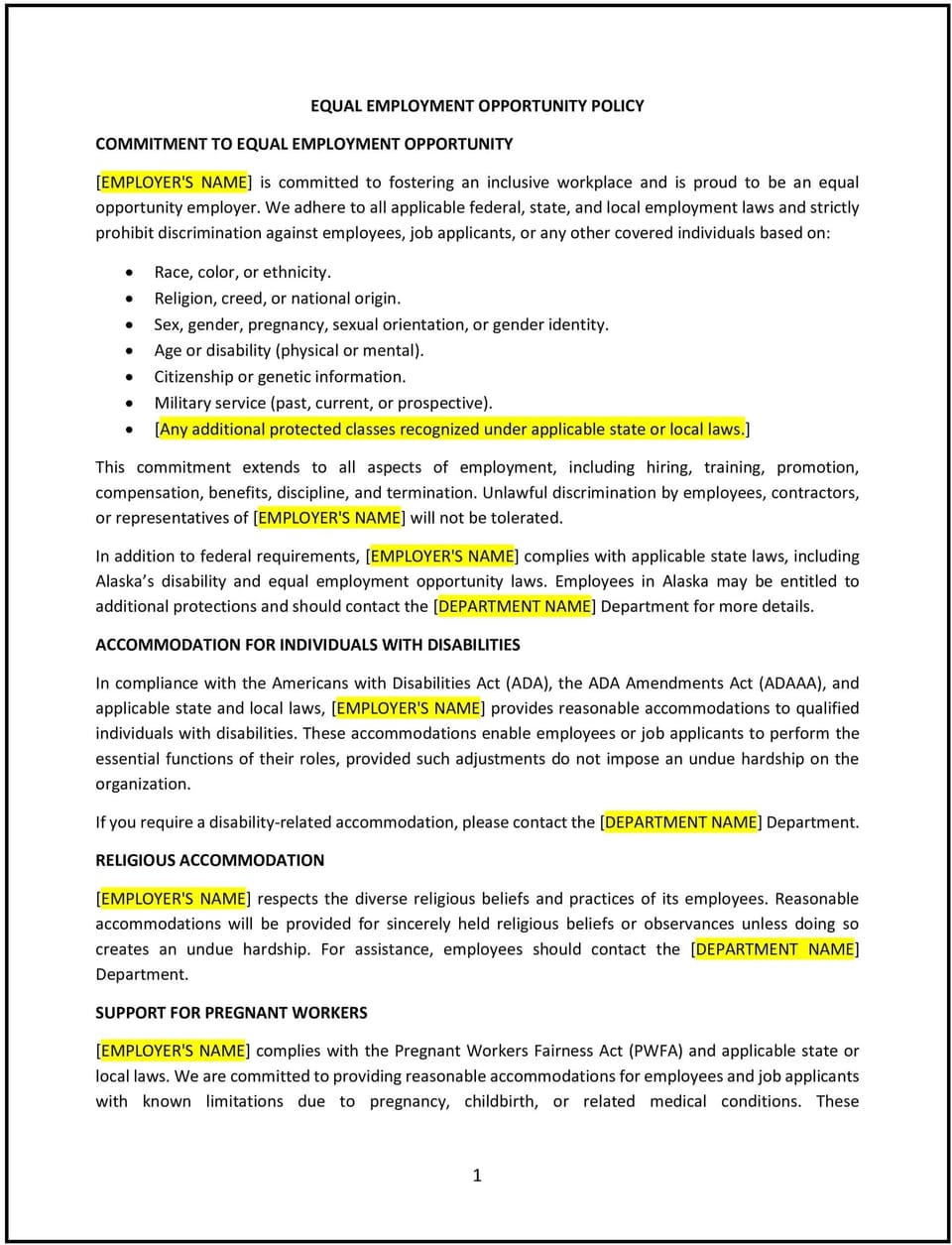Equal employment opportunity policy (Alaska): Free template

Equal employment opportunity (EEO) policy (Alaska)
In Alaska, an equal employment opportunity (EEO) policy outlines a business’s commitment to providing a workplace free of discrimination and ensuring that all employment decisions are based on merit, qualifications, and abilities. This policy ensures compliance with state and federal anti-discrimination laws while fostering a fair and inclusive work environment. By implementing an EEO policy, businesses can demonstrate their dedication to diversity, equity, and inclusion while protecting against legal risks.
Given Alaska’s diverse workforce, including indigenous communities and employees in remote areas, businesses may need to tailor their policies to reflect local cultural and operational considerations.
How to use this equal employment opportunity policy (Alaska)
- Define the policy’s scope: Clearly outline the types of employment actions covered under the policy, such as hiring, promotions, terminations, and compensation.
- Prohibit discrimination: Include a comprehensive list of protected characteristics, such as race, gender, age, disability, religion, and national origin, as outlined by Alaska and federal laws.
- Set reporting procedures: Provide employees with clear steps to report concerns or violations, including contact information for HR or designated personnel.
- Include anti-retaliation measures: Emphasize that employees who raise concerns or file complaints will be protected from retaliation.
- Communicate the policy: Share the EEO policy during onboarding and ensure it is easily accessible to all employees through handbooks or internal portals.
Benefits of using an equal employment opportunity policy (Alaska)
An EEO policy provides significant advantages for businesses in Alaska. Here’s how it helps:
- Promotes inclusivity: Encourages a diverse and equitable workplace where employees feel valued and respected.
- Supports compliance: Helps businesses meet state and federal legal requirements, reducing the risk of discrimination claims or penalties.
- Enhances reputation: Demonstrates the company’s commitment to fairness, attracting top talent and fostering trust with clients and stakeholders.
- Encourages accountability: Provides clear standards for employees and management, ensuring fair and unbiased decision-making.
- Improves employee morale: Fosters a supportive environment where employees are confident in equal opportunities for growth and success.
Tips for using an equal employment opportunity policy (Alaska)
- Tailor to local needs: Consider Alaska’s unique workforce demographics, such as indigenous communities, and include culturally relevant practices in the policy.
- Provide regular training: Offer training on anti-discrimination laws, unconscious bias, and workplace inclusivity to ensure all employees and managers understand their responsibilities.
- Monitor compliance: Establish processes for regularly reviewing employment practices and identifying potential gaps in adherence to the policy.
- Act promptly on complaints: Ensure a swift and thorough investigation process for any reported violations, maintaining confidentiality and fairness.
- Update as needed: Revise the policy to reflect changes in laws, workforce dynamics, or organizational values.
Q: What types of actions are covered under the EEO policy?
A: The policy applies to all employment actions, including hiring, promotions, terminations, compensation, training, and workplace conduct.
Q: How can employees report discrimination concerns?
A: Employees can report concerns by contacting HR or the designated personnel listed in the policy. Anonymous reporting channels may also be provided.
Q: What protections are in place for employees who file complaints?
A: The policy includes anti-retaliation measures to ensure employees who report violations are protected from any adverse actions.
Q: How does this policy support compliance with Alaska laws?
A: The policy aligns with Alaska’s anti-discrimination laws and federal regulations, ensuring fair and equitable treatment for all employees.
Q: How often should the EEO policy be reviewed?
A: The policy should be reviewed annually or whenever significant changes occur in laws, workplace demographics, or company practices.
This article contains general legal information and does not contain legal advice. Cobrief is not a law firm or a substitute for an attorney or law firm. The law is complex and changes often. For legal advice, please ask a lawyer.


